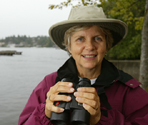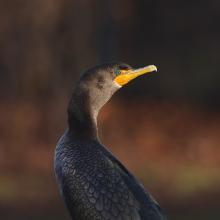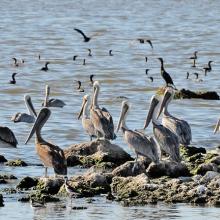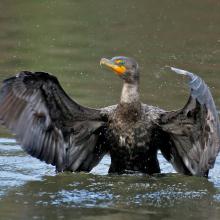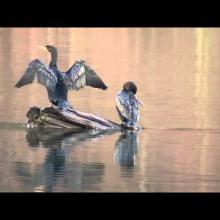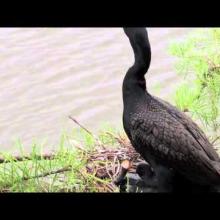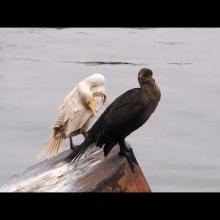

Join BirdNote tomorrow, November 30th!
Illustrator David Sibley and actor H. Jon Benjamin will face off in the bird illustration battle of the century during BirdNote's Year-end Celebration and Auction!
Sitting on a piling, wings outstretched, the Double-crested Cormorant looks like a black Celtic cross. Cormorants dive from the water's surface, pursuing prey under water, propelled by powerful webbed feet. The male performs a flashy wing-waving display to show off his colorful head-tufts and neck. When not nesting, Double-crested Cormorants are a common sight near fresh and salt water.
Support comes from Sasquatch Books, announcing Every Penguin in the World, a narrative and photographic book that chronicles a couple’s quest to see every penguin species on the planet.
BirdNote®
Double-crested Cormorant
Adapted from a script by Frances Wood
This is BirdNote.
[Guttural sounds of Double-crested Cormorant colony]
These deep, guttural sounds are coming from a nesting colony of Double-crested Cormorants.
[Guttural sounds of Double-crested Cormorant]
Large black waterbirds with short legs and long necks. Look closely and you can see the bird’s “double crest” – its two long, gloriously feathered eyebrows. When not nesting, Double-crested Cormorants are a common sight near fresh and salt water. They often sit upright on a rock or piling, holding their wings out to the side, resembling a black Celtic cross. During courtship, they may wave their outstretched wings.
[Guttural sounds of Double-crested Cormorant]
Why do they have such a limited and guttural vocal range when many birds create glorious songs? Well, it has to do with the number of muscles a bird can use to govern its vocal organ, the syrinx. The more you have, the more elaborate the sound. Many song birds have five to seven sets of these muscles. The cormorant has only one.
[Guttural sound from cormorant colony]
You can see a cormorant – and hear one. And even watch it wave its wings. All on BirdNote.org.
For BirdNote, I’m Michael Stein.
###
Sound of the Double-crested Cormorant provided by Kevin J. Colver. Ambient sounds provided by Kessler Productions.
Ambient sounds provided by Kessler Productions.
BirdNote’s theme music was composed and played by Nancy Rumbel and John Kessler.
Producer: John Kessler
Executive Producer: Chris Peterson/Dominic Black
© 2009/2016 Tune In to Nature.org April 2016 / 2018 / 2020 Narrator: Michael Stein
ID#040805DCCOKPLU DCCO-01b-2009-04-03-MS DCCO-01d


